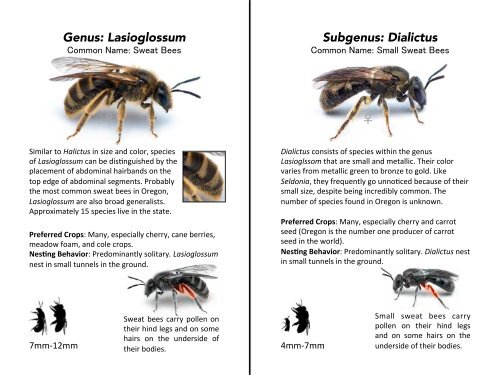You also want an ePaper? Increase the reach of your titles
YUMPU automatically turns print PDFs into web optimized ePapers that Google loves.
Genus: Lasioglossum<br />
Common Name: Sweat Bees <br />
Subgenus: Dialictus<br />
Common Name: Small Sweat Bees <br />
♀ <br />
♀ <br />
Similar to Halictus in size and color, species <br />
of Lasioglossum can be disFnguished by the <br />
placement of abdominal hairbands on the <br />
top edge of abdominal segments. Probably <br />
the most common sweat bees in Oregon, <br />
Lasioglossum are also broad generalists. <br />
Approximately 15 species live in the state. <br />
Preferred Crops: Many, especially cherry, cane berries, <br />
meadow foam, and cole crops. <br />
Nes,ng Behavior: Predominantly solitary. Lasioglossum <br />
nest in small tunnels in the ground. <br />
Dialictus consists of species within the genus <br />
Lasioglssom that are small and metallic. Their color <br />
varies from metallic green to bronze to gold. Like <br />
Seldonia, they frequently go unnoFced because of their <br />
small size, despite being incredibly common. The <br />
number of species found in Oregon is unknown. <br />
Preferred Crops: Many, especially cherry and carrot <br />
seed (Oregon is the number one producer of carrot <br />
seed in the world). <br />
Nes,ng Behavior: Predominantly solitary. Dialictus nest <br />
in small tunnels in the ground. <br />
7mm-‐12mm <br />
Sweat bees carry pollen on <br />
their hind legs and on some <br />
hairs on the underside of <br />
their bodies. <br />
4mm-‐7mm <br />
Small sweat bees carry <br />
pollen on their hind legs <br />
and on some hairs on the <br />
underside of their bodies.


